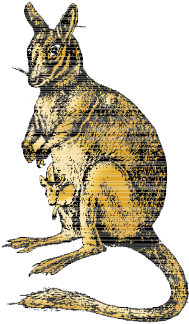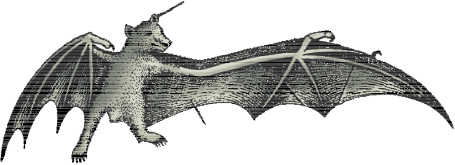They are found in a variety of habitats – polar ice caps, deserts, mountains, forests, grasslands and dark caves. Some of them have adapted to fly or live in water. The most unique mammalian characteristic is the presence of milk producing glands (mammary glands) by which the young ones are nourished. They have two pairs of limbs, adapted for walking, running, climbing, burrowing, swimming or flying (Figure 4.24).

(a)

(b)

(c)

Figure 4.24 Some mammals : (a) Ornithorhynchus (b) Macropus (c) Pteropus (d) Balaenoptera
The skin of mammals is unique in possessing hair. External ears or pinnae are present. Different types of teeth are present in the jaw. Heart is four-chambered. They are homoiothermous. Respiration is by lungs. Sexes are separate and fertilisation is internal. They are viviparous with few exceptions and development is direct.
Examples: Oviparous-Ornithorhynchus (Platypus); Viviparous - Macropus (Kangaroo), Pteropus (Flying fox), Camelus (Camel), Macaca (Monkey), Rattus (Rat), Canis (Dog), Felis (Cat), Elephas (Elephant), Equus (Horse), Delphinus (Common dolphin), Balaenoptera (Blue whale), Panthera tigris (Tiger), Panthera leo (Lion).
The salient distinguishing features of all phyla under animal kingdom is comprehensively given in the Table 4.2.
Table 4.2 Salient Features of Different Phyla in the Animal Kingdom
The basic fundamental features such as level of organisation, symmetry, cell organisation, coelom, segmentation, notochord, etc., have enabled us to broadly classify the animal kingdom. Besides the fundamental features, there are many other distinctive characters which are specific for each phyla or class.
Porifera includes multicellular animals which exhibit cellular level of organisation and have characteristic flagellated choanocytes. The coelenterates have tentacles and bear cnidoblasts. They are mostly aquatic, sessile or free-floating. The ctenophores are marine animals with comb plates. The platyhelminths have flat body and exhibit bilateral symmetry. The parasitic forms show distinct suckers and hooks. Aschelminthes are pseudocoelomates and include parasitic as well as non-parasitic roundworms.
Annelids are metamerically segmented animals with a true coelom. The arthropods are the most abundant group of animals characterised by the presence of jointed appendages. The molluscs have a soft body surrounded by an external calcareous shell. The body is covered with external skeleton made of chitin. The echinoderms possess a spiny skin. Their most distinctive feature is the presence of water vascular system. The hemichordates are a small group of worm-like marine animals. They have a cylindrical body with proboscis, collar and trunk.
Phylum Chordata includes animals which possess a notochord either throughout or during early embryonic life. Other common features observed in the chordates are the dorsal, hollow nerve cord and paired pharyngeal gill slits. Some of the vertebrates do not possess jaws (Agnatha) whereas most of them possess jaws (Gnathostomata). Agnatha is represented by the class, Cyclostomata. They are the most primitive chordates and are ectoparasites on fishes. Gnathostomata has two super classes, Pisces and Tetrapoda. Classes Chondrichthyes and Osteichthyes bear fins for locomotion and are grouped under Pisces. The Chondrichthyes are fishes with cartilaginous endoskeleton and are marine. Classes, Amphibia, Reptilia, Aves and Mammalia have two pairs of limbs and are thus grouped under Tetrapoda. The amphibians have adapted to live both on land and water. Reptiles are characterised by the presence of dry and cornified skin. Limbs are absent in snakes. Fishes, amphibians and reptiles are poikilothermous (cold-blooded). Aves are warm-blooded animals with feathers on their bodies and forelimbs modified into wings for flying. Hind limbs are adapted for walking, swimming, perching or clasping. The unique features of mammals are the presence of mammary glands and hairs on the skin. They commonly exhibit viviparity.